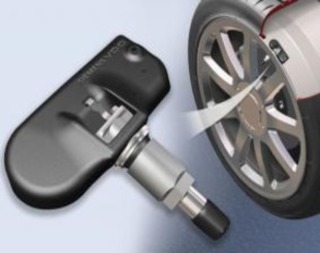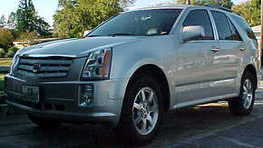
The regulation that requires a dashboard tire pressure monitor system in passenger cars, light trucks and vans appears to be working pretty good for all involved.
This is one of those rare Government directives that offers benefits to automotive consumers without giant increases to manufacturing costs. However, the same cannot be said for drivers with a leaking tire or independent tire dealers who try to fix it.
Shops see operational cost increases from obtaining the automotive technology and training their employee’s. For drivers it means dealing with an additional warning light on the dashboard and cost associated with turning it off.

I finally have my first car with this factory installed system being a 2009 Cadillac SRX that I bought used. I’m surprised how often I have seen the light come to notify me of under-inflation.
On my car this thing is too sensitive in my opinion. It comes on at about 26 PSI when full inflation is 30 psi as recommended by the manufacturer. This doesn’t allow for much slack.
On cold mornings air pressures can be low enough to trigger the warning. As I drive the tires heat up and the pressure increases turning the light off. The problem is I do not drive far so I try to keep the tires inflated to maximum and make sure to fill them cold as intended by the car maker.
The Low Tire Light Will Come On
Those who drive a lot like my sister (see video below) don’t realize how much road debris is out there. I’m talking about the metal kind that can cause tire punctures resulting in slow leaks that turn on the warning lamp.
A quick tip for drivers is that when refilling a tire try having the key on engine off. This allows for quicker detection of pressure increases. When you pick up a nail in the tread area the recommended repair is to remove the tire from the rim and install an inside patch.
This in most cases makes the tire as good as new. A self vulcanizing tire plug is cheaper and more convenient. However, it will continue to get harder over time and it could start leaking again.
An inside patch means a trip to the tire store. So consider the time involved in accommodating tire repair or replacement on vehicles that have the monitor system installed.
Auto Repair Shops and Monitoring Systems
Tire dealers will have to make investments of about $1500 per location in equipment. Things like electronic scanning resetting tools. Plus $200-$400 yearly for software upgrades and new equipment.
Most importantly repair shops and technicians will have to spend more shop time on tire replacement and even rotation service.
The sensors are vulnerable to breakage if handled incorrectly or too hastily. For example a particularly breakage prone area is the air pressure sensor mounted on the inside base of the valve stem.
The sensor is connected to a tiny radio transmitter powered by a long life lithium ion battery that can last up to 10 years or more. This thing transmits information to the dashboard readouts.
Of course the main goal is to warn of under inflation. It’s designed to get the drivers attention using a buzzer, bell or flashing light when a tire has deflated to around 25 percent less than recommended full inflation.

When it comes to handling a tire and wheel assembly with a valve stem mounted sensor, speed is the last thing on the list.
The tire pressure transmitter is vulnerable to breakage, because its made of mostly plastics. A standard tire machine can snap the components like a twig.
For this reason the process of mounting any tire on a wheel with an internal mounted sensor of any kind should be slow and cautious or breakage is likely. It should be the tire dealers responsibility in my opinion to repair any damage caused by their technicians.
Tire Inflation System Facts
Tire pressure monitoring systems began appearing on passenger cars and light trucks in the 2005 model year.
Following a congressional mandate requiring them on all vehicles weighing less than 10,000 pounds, by the 2008 model year. Most pickups, light duty vans, and SUVs fit into this weight category.
This is why most automobile manufacturers installed tire pressure monitoring systems well ahead of the deadline for compliance. The national Highway traffic safety administration proposed the system after a 2001 study.
The study tested 11,000 vehicles and found that 29 percent of the light trucks and cars had at least one tire under inflated. In fact, many of the passenger cars had tires with less than 25 PSI or lower.
Is it a big deal if they’re low? Severely under inflated tires can cause loss of control, hydro planing on wet pavement, longer stopping distances and outright tire failure from overheating.
Properly inflated tires produced better fuel economy and longer tire life, all vehicle tire manufacturers agree with this fact.
On the Silverado and Sierra pickups made by General Motors, the tire pressure warning light is in the driver information center located just beneath the speedometer.
This system also provides the actual pounds per square inch reading for each tire. If a tire were to go below the safe pressure a warning message would appear in the driver information center.
The monitoring system has many benefits identified by the manufacturers of these vehicles and the driving public mostly supports it as well.
The key benefits include improved handling as well as fuel efficiency and the ability of the vehicle to carry loads up to its recommended limits.
Properly inflated tires wear more evenly across the tread contact area. They also provide greater traction and are better able to resist road hazards like nails.
Tire dealers agree, the pressure sensing system will help customers enjoy the performance manufacturers design into tires. Tires are tested at recommended pressure and can behave differently when under inflated.
If monitoring tire pressure leads to better maintenance habits, overall performance and wear will show a marked improvement. However, it still boils down to the drivers responsibility.
Skeptics have questioned whether drivers will take action or just ignore the monitoring system dashboard warning message. But the National Highway Traffic and Safety administration predicts 90 percent of notified drivers will comply with the warning message.
The convenience of being able to instantly read tire pressure on the dashboard instead of individually checking tire pressure with the old-fashioned tire pressure gauge is a huge benefit.
By maintaining proper tire pressure drivers also will enjoy extended tire life. Though the tire pressure monitor system cannot force drivers to comply, the bright tire pressure warning light might just push them toward at least checking tire inflation levels.
Growing in popularity is the automotive news section of the auto facts website. This next link takes you from this page about tire pressure monitor system to more automotive news. This next link takes you to the about us page that is currently also the homepage for this car fans website. Here you will find more answers to auto facts.org homepage.
